10. Air pollution
| indicator |
policy issue |
DPSIR |
assessment |
| Multiple effects: |
| area with exceedance of critical
loads for acidity and eutrophication |
how much have we protected the
environment against acid precipitation? |
state |
 / /  |
| limit value exceedance days for
atmospheric ozone |
are we protecting the population
effectively against exposure to photochemical substances? |
state |
 |
| exposure of crops and forests to
atmospheric ozone |
how much have we
protected the environment against the effect of photochemical
substances? |
state |
 |
| limit value exceedance days for
particulate matter |
are we protecting the population
effectively against exposure to particulate matter? |
state |
 |
| Multiple pollutants: |
| emissions of acidifying gases |
will policy targets be
reached? |
pressure |
 |
| emissions of ozone precursors |
- " - |
pressure |
 |
| emissions of sulphur dioxide |
- " - |
pressure |
 |
| emissions of nitrogen oxide |
- " - |
pressure |
 |
| emissions of ammonia |
- " - |
pressure |
 |
| emissions of non-methane volatile
organic compounds |
- " - |
pressure |
 |
Despite a decline in emissions of general
air pollutants, the ultimate goal of avoiding all harmful effects
on health, vegetation, water and soil has still to be achieved. The
area where the critical load of acidifying emissions is exceeded
has fallen significantly, but substantial parts of the population
in EEA member countries are exposed to unacceptable concentrations
of ground-level ozone and fine particles. The fifth environmental
action programme emission reduction targets for 2000 will be
achieved for sulphur dioxide, but are unlikely to be met for
nitrogen oxides and volatile organic compounds (VOCs). The proposed
EU and national 2010 targets for sulphur dioxide appear achievable,
but reaching those for nitrogen oxide, ammonia and VOC emissions
will require substantial further reductions and additional policies
and measures in most Member States.
The main environmental problems associated with
air emissions are harm to human health, the acidification and
eutrophication of water and soils, and damage to natural
ecosystems, cultural heritage and crops. Often these are
transboundary effects, as pollutants in the air can travel a
considerable distance away from their source. In addition,
emissions from sources in urban areas can have a significant local
impact on human health. Local and transboundary air pollution are
considered as one environmental issue in this report, since the
effects of air pollution are interrelated through common causes and
common impacts. Policies to reduce emissions are increasingly
considering various pollution problems together in a
multi-pollutant, multi-effect approach (Figure 10.1).
Figure 10.1:
Multi-pollutants, multi-effects

Source:
EEA
10.1. Policy update
The first international treaty with strategies
for reducing transboundary air pollution was the UNECE Convention
on Long Range Transboundary Air Pollution (CLRTAP). Several CLRTAP
Protocols are in force for its European parties, including the EU
and its Member States. The substances covered and the required
reductions are listed in Table 10.1. The Second Sulphur Protocol
(UNECE, 1994) used the approach, for the first time, of setting
emission targets to reduce the exceedance of critical deposition
levels for ecosystems (‘gap closure’). This Protocol thus resulted
in national emission-reduction commitments that varied according to
the ecosystems’ sensitivity.
In May 1999, the European Commission presented
a proposal for a Directive on national emission ceilings (NECD)
(European Commission, 1999a) for the same pollutants as CLRTAP and,
for the first time, for ammonia. The proposed Directive uses a
similar approach as the Second Sulphur Protocol, but extends it to
include reduction in exceedance of critical limit values for ozone
for human health and ecosystems. These targets in the NECD
proposal, which has not yet been adopted, are much stricter than
currently agreed targets.
In a parallel process, on 1 December 1999 the
CLRTAP agreed on national emission ceilings for many European
countries (including EU Member States) in a new multi-pollutant
Protocol for the same four pollutants as NECD. For a number of
Member States, however, the targets are less strict than those in
the proposed Directive.
Table 10.1 summarises the main current and
proposed targets for the EU.
| Table 10.1: Air emissions reduction
targets for the EU and its member states |
| Policy/Pollutant |
Base year |
Target year |
Reduction (%) |
|
UNECE-CLRTAP
Sulphur dioxide1
|
1980
|
2000
|
62
|
| Sulphur dioxide4 |
1990 |
2010 |
75 |
| Nitrogen oxides2 |
1987 |
1994 |
stabilisation |
| Nitrogen oxides4 |
1990 |
2010 |
50 |
| Non-methane VOCs3 |
1987 |
1999 |
30 |
| Non-methane VOCs4 |
1990 |
2010 |
58 |
|
Ammonia
5EAP
Sulphur dioxide
|
1990
1985
|
2010
2000
|
12
35
|
| Nitrogen oxides |
1990 |
2000 |
30 |
|
Non-methane VOCs
NECD (proposed targets)5
Sulphur dioxide
|
1990
1990
|
1999
2010
|
30
78
|
| Nitrogen oxides |
1990 |
2010 |
55 |
| Non-methane VOCs |
1990 |
2010 |
62 |
| Ammonia |
1990 |
2010 |
21 |
|
Source: EEA |
Notes:
1 Target from the 1994 Second Sulphur Protocol. The different
emission ceilings for each Member State correspond to a 62 %
emission reduction for the EU.
2 Targets from first NOx Protocol.
These are the same for individual Member States and for the EU.
3 Targets from NMVOCs Protocol. These are the same for
individual Member States and for the EU.
4 Targets from the multi-pollutant Protocol (1 December
1999). The emission reduction target for the EU that corresponds
with different emission ceilings for each Member State is
shown.
5 Targets from the European Commission’s 1999 proposal
for a national emission ceilings directive (NECD). The emission
reduction target for the EU that corresponds with different
emission ceilings for each Member State is shown.
To help reach these targets, current European
Community legislation aimed at reducing acidifying pollutants and
ozone precursors includes a Directive on the reduction of emissions
from large combustion plants and various recent Directives on
vehicle emissions, the quality of petrol and diesel fuels and the
sulphur content of certain liquid fuels. A Directive on the storage
and distribution of petrol and the Solvents Directive on the
reduction of emissions from the industrial use of organic solvents
both aim to limit emissions of volatile organic compounds (VOCs).
By the end of 1999, new proposals are expected from the second
Auto-Oil Programme for emission limits on new cars, other technical
measures and non-technical measures to encourage more
environmental-friendly modes of transport. There is currently no EU
legislation aimed at reducing ammonia emissions. Legislation and
targets for abatement of direct emissions of fine particles are
also still lacking.
In addition, measures to reduce greenhouse gas
emissions (particularly carbon dioxide) could, as a side effect,
reduce acidifying substances and ozone precursors. One such measure
is fuel switching to natural gas.
The proposed national emission ceilings for
2010 should be regarded only as interim as they will not provide
full protection to ecosystems and human health. Assuming a baseline
scenario (EEA, 1999), some ecosystems in 2010 will still be
receiving deposition above critical loads, and threshold values for
ozone will continue to be exceeded. Future development of policies
and measures in the coming years are likely be performed in
parallel by UNECE/CLRTAP and the EU, following the same approach as
for the recently proposed emission ceilings.
This chapter begins by using four indicators to
evaluate developments in meeting critical limit values. These
indicators equate approximately to the major impacts of air
pollutants, i.e. acidification and eutrophication of water, soil
and ecosystems; human-health effects of ground-level ozone;
ecosystem effects of ozone; and human health impacts of particulate
matter. This concise overview of progress in limiting multiple
effects is followed by two indicators summarising the reduction in
most of the pollutants involved. The distance to the various
emission targets listed in Table 10.1 gives an indication of the
amount of policy effort still required. The chapter concludes with
a number of indicators on emissions and the gap between the target
and actual reductions for the individual pollutants.
10.2. Multiple effects
10.2.1. Impact 1: Acidification and
eutrophication of water, soils and ecosystems
The area where critical loads are exceeded
due to emissions of sulphur and nitrogen oxides falling on water
and soils (deposition) has decreased substantially since 1985 (Figure 10.2). Both sulphur and
nitrogen deposition contribute to the acidification of water and
soils; the lines in Figure 10.2
for the exceedance in critical loads for acidifying sulphur and
acidifying nitrogen therefore run in parallel. However, the
decrease in areas exposed to acidification appears to be due mainly
to the decrease in sulphur oxide emissions (see Figure 10.6). Much of the deposited
nitrogen accumulates in the soil or is taken up by vegetation and
thus will contribute at some stage to eutrophication. The area
where depositions of nitrogen exceed the critical load has remained
high, reflecting insufficient reduction of nitrogen oxide and
ammonia emissions (see Figures
10.10 and 10.12).
Figure 10.2:
Percentage area where critical loads for
acidity and eutrophication are exceeded in EEA member countries

Source:
CCE for critical loads and EMEP/MSC-W for deposition estimates
Note:
Figure shows area where 5th percentile critical loads for acidity
and eutrophication are exceeded.
 Since 1985, there has been about a 40 % reduction in the area where
critical loads for acidity are exceeded.
Since 1985, there has been about a 40 % reduction in the area where
critical loads for acidity are exceeded.
 The ecosystem area exposed to eutrophication has not changed much
and is still high.
The ecosystem area exposed to eutrophication has not changed much
and is still high.
10.2.2. Impact 2: Human-health impacts due
to exposure to ozone
Large numbers of people living in EEA member
countries are exposed to ground-level ozone concentrations above
the proposed EC threshold value (Figure 10.3).
Ozone concentrations at ground level are far
higher than they would be naturally because additional ozone is
formed by photochemical reactions in the atmosphere. The main
substances with a role in ground-level ozone formation (i.e. ozone
precursors) are nitrogen oxides, non-methane volatile organic
compounds (NMVOCs), carbon monoxide and methane.
Ozone is an oxidant that can induce damage to
human health (European Commission,1999b). Epidemiological and
toxicological evidence indicates that exceedances of threshold
values during summer smog episodes have lead to associated health
problems, particularly inflammatory responses and impaired lung
function. Multiannual exposure to high concentrations of ozone may
lead to decrements in the lung function of young children (Frischer
et al., 1999).
Insufficient data and strong year-on-year
fluctuations owing to episodes of high ozone concentrations prevent
clear conclusions on time trends. However, the limited monitoring
data suggests that peak concentrations are decreasing.
The reduction in emissions of ozone precursors
achieved in the EU (see Figure
10.7) has not yet been sufficient to make a significant
difference to health risk. Increased background concentrations –
caused by emissions in the whole northern hemisphere – are
partially responsible for continued high concentrations in EEA
member countries.
Despite projected further emission reductions,
ozone concentrations are expected to exceed EC threshold values
over all EEA member countries in the next decade (EMEP, 1999). By
2010, north-western European areas are expected to comply with the
proposed EU target value of only 20 exceedance days per year in the
long-term air quality objective (European Commission 1999b).
Figure 10.3:
Population exposure in EEA member countries
to ozone levels above EC targets

Source:
AIRBASE
Notes:
Number of days per year with 8-hour rolling average concentration
greater than 120 µg/m3. Based on data from rural
monitoring stations. Ozone concentrations in urban areas are often
lower than rural concentrations, due to local reactions with
nitrogen oxides from traffic emissions. The population exposure may
therefore be somewhat overestimated.
 A substantial part of the population in EEA member countries is
exposed to ozone concentrations above the proposed EC target.
Monitoring data suggests that ozone peak values are decreasing.
A substantial part of the population in EEA member countries is
exposed to ozone concentrations above the proposed EC target.
Monitoring data suggests that ozone peak values are decreasing.
10.2.3. Impact 3: Damage of forest and crops
due to exposure to ozone
Exposure to ozone can induce foliar injury
in plants and thus reduce crop and forest yields. The forested area
where critical ozone concentrations have been exceeded is smaller
than the affected area of arable land (Figure 10.4). However, the proposed
long-term critical level for forests is less stringent than the
proposed EC guideline for crops. Significant fluctuations between
years and lack of data for over 50 % of the relevant area prevent
definitive conclusions on trends being drawn.
Despite the expected reductions in the
emissions of ozone precursors following the implementation of the
CLRTAP protocol and EU legislation, ozone concentrations are
forecast to remain well above the critical levels for the next
decade. By 2010, the gap between current concentrations and
critical values is expected to have halved (EMEP, 1999).
Figure 10.4:
Exposure of agricultural crops and forests in EEA member countries
to atmospheric ozone


Source:
EEA-ETC/AQ and EMEP/CCC
Note:
Proposed EC long-term critical level is 20 mg/m3h
(AOT40) for forests and 6 mg/m3h (AOT40) for
agricultural crops.
 A substantial proportion of forests and crops in EEA member
countries are exposed to ozone levels greater than proposed EC
critical levels.
A substantial proportion of forests and crops in EEA member
countries are exposed to ozone levels greater than proposed EC
critical levels.
10.2.4. Impact 4: Human-health problems from
exposure to particulates
Recent research has shown that exposure to
fine particles in the air is associated with a significant impact
on human health (UNECE/WHO, 1999). The health effects attributed to
fine particulates range from increased frequency and severity of
respiratory problems to increased risk of premature
death.
In preparation for implementing the EC Air
Quality Daughter Directive, most countries have only recently
introduced monitoring of particulate matter less than 10 µm in
diameter (PM10), Data on PM10 concentrations is currently
insufficient to draw firm conclusions about emission trends.
However, concentrations of total suspended particulates (TSP) and
black smoke are generally decreasing (Figure 10.5).
Particulate matter originates both from direct
air emissions (primary particles) and from atmospheric reactions
between sulphur and nitrogen oxides, and ammonia and organic
compounds (secondary particles). Emissions of precursors of
secondary particles are limited by existing environmental
legislation, but there is no EU legislation directly governing
primary particle emissions.
Air-pollution control techniques designed to
reduce precursor emissions often reduce primary particulate
emissions. However, PM10 concentrations are expected to remain well
above limit values in most urban areas of EEA member countries in
the coming decade. This suggests that more measures need to be
taken to reduce human-health risks significantly (European
Commission,1999c).
Figure 10.5:
Exposure to particulate matter in urban
areas of EEA member countries

Source:
AIRBASE
Notes:
Shows number of days when 24-hour average particulates threshold
value is exceeded, averaged over all monitoring stations. The
threshold value taken depends on the type of particulates measured:
for PM10 (fine particulate matter) 50 µg/m3, for total
suspended particulates (TSP) 120 µg/m3 and for black
smoke 125 µg/m3. The implicit assumption is that an
exceedance day for TSP is just as bad as an exceedance day for
black smoke or PM10. Only a small proportion of the population is
covered by the monitoring network.
 Many people living in towns and cities in EEA member countries are
exposed to higher concentrations of fine particulate matter than EC
limit values.
Many people living in towns and cities in EEA member countries are
exposed to higher concentrations of fine particulate matter than EC
limit values.
10.3. Multiple pollutants
Emissions of gases causing acidification and
eutrophication (sulphur dioxide, nitrogen oxides and ammonia) have
decreased significantly in most EU Member States. Sulphur dioxide
and nitrogen oxides also have health impacts. In the EU as a whole,
emissions decreased by 27 % between 1990 and 1996 (Figure 10.6), despite an increase in
gross domestic product (GDP).
The substantial fall in acidifying gases is
mainly due to a reduction of over 60 % in sulphur dioxide emissions
from industry and the energy sector since 1980 (see Figure 10.8). However, nitrogen oxide
emissions decreased much less and are unlikely to meet the fifth
environment action programme (5EAP) target for 2000. Ammonia
emissions are stabilising (see Figures 10.12 and 10.13). The slower
reduction in nitrogen oxide and ammonia emissions is reflected in a
less significant reduction in deposited nitrogen and in the area in
which the critical load for eutrophication is exceeded (see Figure
10.2).
Substantial further reductions of emissions of
acidifying pollutants are needed to achieve the proposed NECD
targets or even the less strict CLRTAP targets for 2010 agreed on 1
December 1999.
Figure 10.6:
Total EU emissions of acidifying gases

Source:
EEA-ETC/AE and UNECE/EMEP
Notes:
Emission reduction targets are for the EU and combined for the
three gases using weighting factors. Acidifying equivalents per kg
used for weighting are: sulphur dioxide 31.2; nitrogen oxides 21.7;
ammonia 58.8. Table 10.1 gives more information on the
targets.
 Emissions of acidifying gases in EU Member States have decreased
significantly, showing a clear de-coupling from GDP growth. This
decrease was mainly due to reductions in sulphur dioxide emissions.
Further reductions in nitrogen oxide and ammonia emissions will be
necessary to achieve the targets for 2010.
Emissions of acidifying gases in EU Member States have decreased
significantly, showing a clear de-coupling from GDP growth. This
decrease was mainly due to reductions in sulphur dioxide emissions.
Further reductions in nitrogen oxide and ammonia emissions will be
necessary to achieve the targets for 2010.
Emissions of gases that can lead to
ground-level ozone fell in most EU Member States and by 15 % in the
EU as a whole between 1990 and 1996 (Figure 10.7). These results
were achieved despite an increase in gross domestic product. The
reduction is mainly due to fewer VOC emissions, which fell by 13 %
between 1990 and 1996 mainly due to limits on industrial emissions
and measures to reduce emissions from road vehicles (see Figure
10.14). Although these reductions appear to have decreased peak
concentrations of ozone, they have not been enough to limit human
health and ecosystem risks significantly (see Figures 10.3 and
10.4). Further initiatives are needed to meet the 5EAP targets for
2000.
Substantial further reductions of emissions of
ozone precursor pollutants are required to achieve the proposed
NECD targets or even the less strict CLRTAP targets for 2010.
Figure 10.7:
Total EU emissions of ozone precursors
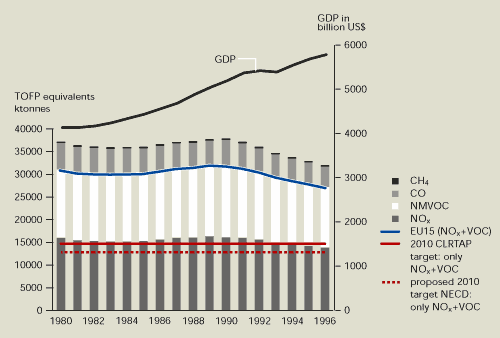
Source:
EEA-ETC/AE and UNECE/EMEP
Notes:
This indicator is a first attempt at weighting total EU ozone
precursor emissions, but of course it is an oversimplification. In
many regions, nitrogen oxide emissions enhance ozone formation, but
in urban areas, they can deplete ozone. A decrease in aggregated
emissions does not therefore imply a similar decrease in ozone
concentrations. Emissions are combined for four ozone precursors,
but reduction targets exist only for the two main precursors
(nitrogen oxides and non-methane VOCs). Weighting factors
(tropospheric ozone precursor potentials) used: nitrogen oxides
1.22; non-methane VOCs 1.00; carbon monoxide 0.11, methane 0.014.
Table 10.1 gives more information on the targets.
 Emissions of ozone precursors in EU Member States have
decreased, showing a de-coupling from GDP. However, substantial
further reductions in emissions are required to achieve the targets
for 2010.
Emissions of ozone precursors in EU Member States have
decreased, showing a de-coupling from GDP. However, substantial
further reductions in emissions are required to achieve the targets
for 2010.
10.4. Achievement of policy targets: individual
substances
This section presents an overview of the
development in emissions compared with the various targets for each
of the four pollutants that contribute to acidification,
eutrophication and ground-level ozone.
10.4.1. Sulphur dioxide
Main sources:
energy (60 %), industry (25 %), transport (6 %) and household (1 %)
sectors (Figure 10.8).
Development in emissions: a decrease of over 60 % from 1980 (over 40> % since
1990) in the EU. Largest reduction in the energy and industry
sectors, due to a switch from coal to natural gas, construction of
new power plants, use of low-sulphur coal and more flue-gas
desulphurisation.
Distance to target: EC’s 5EAP target (-35 % of 1985 emissions by 2000)
reached by EEA member countries in 1992. By 1996, emissions had
fallen to 55 % below 1985 levels. In 1996, the EU as a whole
achieved the CLRTAP Second Sulphur Protocol target (-62 % from 1980
emissions by 2000). There are important differences between Member
States in approaching the proposed NECD and agreed CLRTAP targets
for 2010 (Figure 10.9).
Outlook: EU
baseline scenario (EEA, 1999) projection: -70 % in 2010 from 1990
levels. For some countries, additional measures will be required to
achieve the proposed NECD and agreed CLRTAP Protocol
targets.
Figure 10.8:
Total EU sulphur dioxide emissions from major sources compared to
EU and CLRTAP targets
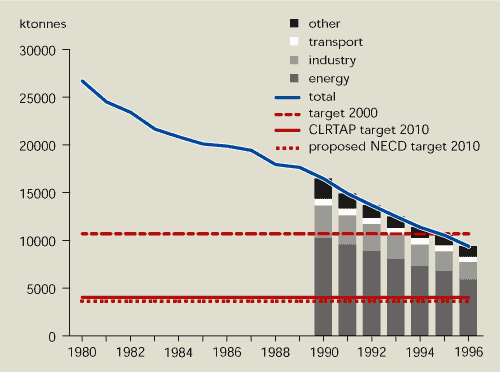
Source:
EEA-ETC/AE and UNECE/EMEP
Note:
Target 2000 refers to the EC’s 5EAP target. The proposed NECD
target requires a 78 % reduction below 1990 emissions by 2010 and
the CLRTAP Protocol (1 December 1999) target a 75 % reduction below
1990 emissions by 2010.
Figure 10.9:
Percentage change in national sulphur dioxide emissions in EU
Member States, 1990-1996

Source: EEA and
UNECE/EMEP
Notes: A
reduction in emissions from 1990 is shown by a negative
percentage.
 Since 1980, EEA member countries have reduced their sulphur dioxide
emissions by over 60 %. Reduction targets for 2000 have already
been achieved for the EU as a whole. The targets for 2010 appear to
be attainable for the EU, although additional measures will be
required in some countries.
Since 1980, EEA member countries have reduced their sulphur dioxide
emissions by over 60 %. Reduction targets for 2000 have already
been achieved for the EU as a whole. The targets for 2010 appear to
be attainable for the EU, although additional measures will be
required in some countries.
10.4.2. Nitrogen oxide
Main sources:
transport (55 %) energy (19 %) and industry (14 %) sectors (Figure
10.10).
Development in emissions: a decrease of 14 % since 1990 in EU Member States,
mainly due to the introduction of catalysts on new cars and
improved abatement in the energy and industry sectors. Increasing
road travel has partly offset reductions achieved by emission
abatement. Emissions increased in some countries (Figure
10.11).
Distance to target: First CLRTAP Nitrogen Oxide Protocol target
(stabilising to 1987 emissions by 1994) achieved by the EU as a
whole and by most Member States. However, the fifth environment
action programme target of a 30 % reduction by 2000 with respect to
1990 will not be achieved.
Outlook: EU
baseline scenario (EEA, 1999) projection: -45 % in 2010 from 1990
emissions. It will be difficult to achieve the proposed NECD and
agreed CLRTAP Protocol targets. Additional policies and measures
will be required in various EU Member States.
Figure 10.10:
Total EU nitrogen oxide emissions from major sources compared to EU
and CLRTAP targets

Source: EEA and
UNECE/EMEP
Note:
Target 2000 refers to the EC's 5EAP target of a 30 % reduction in
emissions below 1990 levels by 2000. The proposed NECD target
requires a 55 % reduction below 1990 emissions by 2010 and the
CLRTAP Protocol target (1 December 1999) a 50 % reduction below
1990 emissions by 2010.
Figure 10.11:
Percentage change in national nitrogen oxide emissions in EU Member
States, 1990-1996
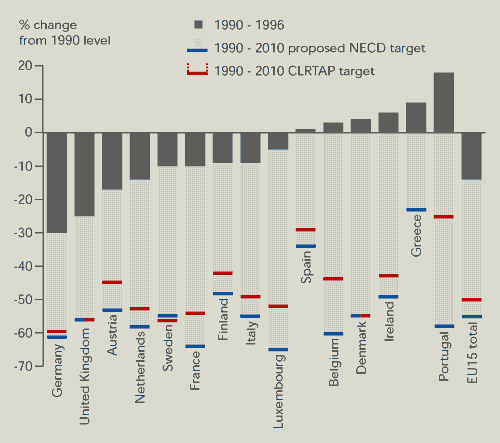
Source:
EEA and UNECE/EMEP
Note: A
reduction in emissions from 1990 is shown by a negative
percentage.
 The CLRTAP target of stabilising nitrogen oxide emissions at
1987 levels was achieved by the EU as a whole. However, the EC’
5EAP target is unlikely to be reached by 2000. The targets for 2010
will also be difficult to achieve for the EU and additional
measures will be required for various countries.
The CLRTAP target of stabilising nitrogen oxide emissions at
1987 levels was achieved by the EU as a whole. However, the EC’
5EAP target is unlikely to be reached by 2000. The targets for 2010
will also be difficult to achieve for the EU and additional
measures will be required for various countries.
10.4.3. Ammonia
Main sources:
agriculture, particularly livestock (pigs, cattle, sheep and
poultry) (Figure 10.12).
Development in emissions: Slight decrease between 1990 and 1996, due to reduced
agricultural activity and measures taken by a few Member States. A
reduction in Denmark, Germany and the Netherlands of over 10 %
achieved. Emissions from some Member States increased (Figure
10.13). Estimates of ammonia emissions are more uncertain than
those for sulphur dioxide and nitrogen oxide.
Distance to target: Until recently no targets existed for ammonia. The
proposed NECD target is a 21 % reduction and the agreed CLRTAP
Protocol a 12 % reduction below 1990 emissions by 2010.
Outlook: EU
baseline scenario (EEA, 1999) projection: -14 % in 2010 from 1990
emissions. Changes in agricultural practice to promote better
manure management (e.g. ploughing in manure spread onto fields) and
fewer animal numbers are expected to help reduce ammonia emissions.
For the countries mentioned above and some other EU Member States,
additional policies and measures will be required to meet the
proposed NECD and agreed CLRTAP targets.
Figure 10.12:
EU total ammonia emissions from major sources compared to EU and
CLRTAP targets
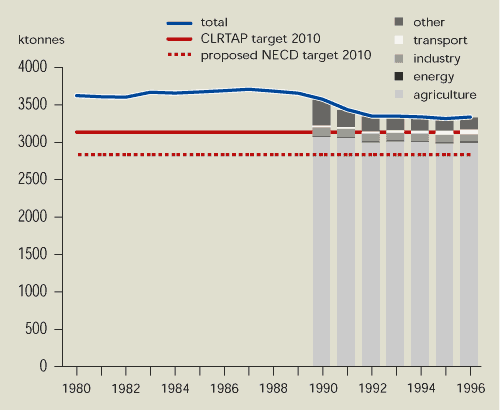
Source:
EEA and UNECE/EMEP
Note: The
proposed NECD target requires a 21 % reduction and the agreed
CLRTAP Protocol target (1 December 1999) a 12 % reduction below
1990 emissions by 2010.
Figure 10.13:
Percentage change in national ammonia emissions in EU Member
States, 1990-1996
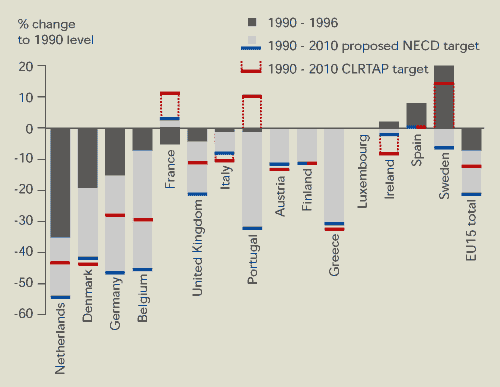
Source:
EEA and UNECE/EMEP
Notes: A
reduction in emissions from 1990 is shown by a negative
percentage.
 Reduction targets have been defined for the first time for
ammonia emissions. The targets for 2010 will be difficult to reach
for the EU and additional measures will be required for various
countries.
Reduction targets have been defined for the first time for
ammonia emissions. The targets for 2010 will be difficult to reach
for the EU and additional measures will be required for various
countries.
10.4.4. Non-methane volatile organic
compounds (NMVOCs)
Main sources:
transport sector (Figure 10.14). The category 'other' in Figure
10.14 comprises emissions from solvent use and the storage and
distribution of fossil fuels.
Development in emissions: decrease by 14 % in EU and decreases in most Member
States (Figure 10.15) due to the introduction of catalytic
converters in vehicle exhausts. Increasing road travel has partly
offset reductions achieved by emission abatement. VOC emissions
from solvent use and manufacturing processes have been reduced
through best practice, substitution by water-based products and
pollutant-abatement technology. These efforts are expected to
increase with the implementation of the Solvents
Directive.
Distance to target: The CLRTAP NMVOC Protocol target (-30 % below 1988
emissions by 1999 for EU Member States) has not been achieved. The
Fifth Environmental Action Programme target (-30 % below 1990
emissions by 2000) appears unlikely to be achieved.
Outlook: EU
baseline scenario (EEA, 1999) projection: - 49 % in 2010 from 1990
emissions. Current policies are not enough to reach the proposed
NECD (-62 %) and the agreed CLRTAP Protocol (-59 %) targets.
Additional policies and measures will be required in various EU
Member States.
Figure 10.14:
Non-methane volatile organic compound emissions in EU Member States
from major sources compared to EU and CLRTAP targets

Source:
EEA-ETC/AE and UNECE/EMEP
Note:
Target 1999 refers to the EC's 5EAP target of a 30 % reduction in
emissions below 1990 levels by 2000. The proposed NECD target
requires a 62 % reduction and the agreed CLRTAP Protocol target (1
December 1999) a 59 % reduction below 1990 emissions by
2010.
Figure 10.15:
Percentage change in national NMVOC emissions in EU Member States,
1990-1996
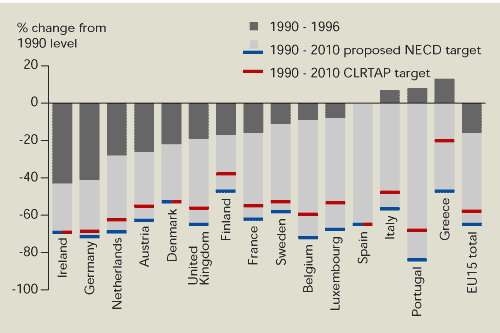
Source:
EEA-ETC/AE and UNECE/EMEP
Note: A
reduction in emissions from 1990 is shown by a negative
percentage.
 Total EU emissions of non-methane volatile organic compounds
fell by 13 % between 1990 and 1996. However, the EC’s 5EAP target
for 2000 will be difficult to achieve and reaching the targets for
2010 will require substantial further reductions in emissions.
Additional measures will be required for various countries.
Total EU emissions of non-methane volatile organic compounds
fell by 13 % between 1990 and 1996. However, the EC’s 5EAP target
for 2000 will be difficult to achieve and reaching the targets for
2010 will require substantial further reductions in emissions.
Additional measures will be required for various countries.
10.5. Indicator development
The spatial coverage requires improvement for
current exposure indicators. A greater consistency between years is
necessary to properly assess exposure to air pollutants and
especially population exposure to particulates. A combination of
modelling and monitoring data could provide a better estimate of
environmental indicators in areas with unsatisfactory data
coverage. Information from different indicators could be combined
to produce simple indexes to monitor the state of the
environment.
The main requirement for the emission
indicators is improved reliability and completeness of the time
series and a reduction in the uncertainty in the estimates. To
achieve consistency, use of the same methodology for all years is
required. There is also a need for further validation and checking
within the framework of UNECE/CLRTAP, in particular by the Task
Force on Emission Inventories and related EEA (ETC/AE)
activities.
Separate indicators for urban emissions,
including PM10 emissions, should be developed because such
emissions have a major impact on urban air quality and related
health effects, while trends may differ significantly from national
totals.
Emission indicators for other pollutants, e.g.
heavy metals and persistent organic compounds, are still missing.
Future developments could also include indicators on other
environmental effects (including ecosystems and material corrosion)
and an indication of the cost-effectiveness of measures and
policies to reduce emissions.
Indicators could also be developed to visualise
the effects of policy responses to trends in air emissions and air
quality. Emission reductions resulting from policy and technical
measures could be presented together with the actual emissions and
in relation to a ‘reference’ emission – a hypothetical emission
level for the situation where no policies/measures are
implemented.
Two examples from the Netherlands are presented
below. The first example is for sulphur dioxide emissions from
power plants (Figure 10.16). A shift in fuel from oil to natural
gas produced a net downward effect on emissions until the
mid-1980s, when greater use of coal reversed the trend. Flue-gas
desulphurisation units began to be fitted to Dutch power plants in
1986 and, by 1996, 96 % were equipped.
Figure 10.16:
Sulphur dioxide emissions from power plants in the Netherlands,
1980-1994
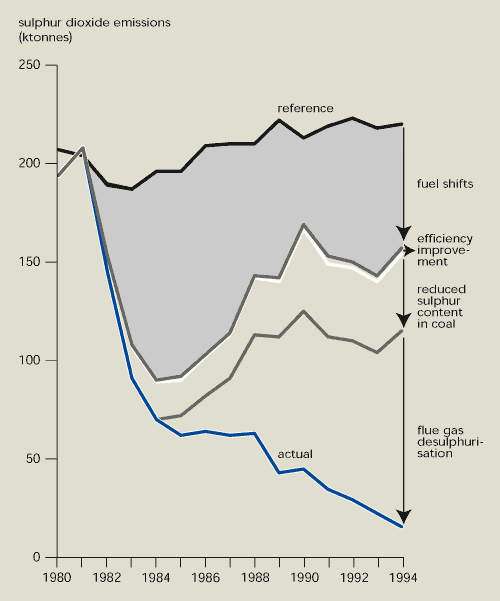
Source:
RIVM
Note: The
reference line is based on electricity produced.
The second example deals with the effectiveness
of measures to reduce nitrogen oxide emissions from motor vehicles
in the Netherlands (Figure 10.17). Emissions fell substantially
following the introduction of catalytic converters in 1988. Until
1993, use of catalytic converters was stimulated by a lower sales
tax on new cars. In 1993, new emission standards came into force
that could only be met with a three-way converter. In 1994, 33 % of
all passenger cars were equipped with a catalytic converter. While
most of the recent decrease in nitrogen oxide emissions is due to
the use of catalytic converters, the shift from petrol to diesel
has also contributed (diesel cars tended until recently to have
lower emissions per kilometre than petrol cars).
Figure 10.17:
Nitrogen oxide emissions from traffic in the Netherlands,
1980-1994
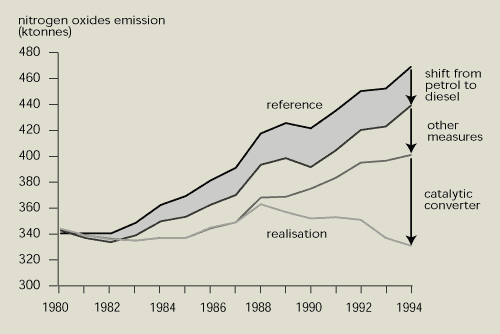
Source:
RIVM
Note: The
reference line is based on the distance driven by road and for
goods transport on tonne-kilometres.
10.6. References and further reading
EMEP (1999) Transboundary Photo-oxidants in
Europe, EMEP Summary Report 2/99. EMEP/Meteorological
Synthesising Centre-West, Oslo.
European Commission (1999a). Proposal for a
Directive setting national emission ceilings for certain
atmospheric pollutants and for a Daughter Directive relating to
ozone in ambient air. COM (99)125. European Commission,
Brussels.
European Commission (1999b). Ozone position
paper. (to be published). European Commission DG
Environment-D3, Brussels.
European Commission (1999c). The Auto-Oil
II Programme, draft version 5.0 , November 1999. European
Commission, Brussels.
European Environment Agency (1999).
Environment in the European Union at the turn of the century.
European Environment Agency, Copenhagen.
Frischer T., Studnicka M., Gartner C., Tauber
E., Horak F., Veiter A., Spengler J., Kühr J., Urbanek R. (1999).
Lung function growth and ambient ozone. A three-year population
study in schoolchildren. Am. J. Respir. Crit. Care Med., 160,
390-396.
UNECE (1994). Protocol to the convention on
long-range transboundary air pollution on further reduction of
sulphur emissions (1994 Sulphur Protocol). UN Economic
Commission on Europe, Geneva.
UNECE (1996). 1979 Convention
on long-range transboundary air pollution. UN
Economic Commission on Europe, Geneva.
UNECE (1999). Protocol to the 1979
convention on long-range transboundary air pollution (CLRTAP) to
abate acidification, eutrophication and ground-level ozone,
Gothenburg, Sweden, 1 December 1999.
UNECE/EMEP (1999). EMEP Emission data,
status report 1999. Report 1/1999, EMEP/MSC-W, Oslo.
UNECE/WHO (1999). Health risk of
particulate matter from long-range transboundary air pollution-
preliminary assessment. Task Force on Health Aspects of
Long-Range Transboundary Air Pollution, Geneva.


















Document Actions
Share with others